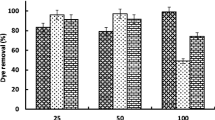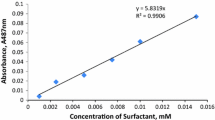Abstract
Purpose
Biodegradation and biodecolorization of Drimarene blue K2RL (anthraquinone) dye by a fungal isolate Aspergillus flavus SA2 was studied in lab-scale immobilized fluidized bed bioreactor (FBR) system.
Method
Fungus was immobilized on 0.2-mm sand particles. The reactor operation was carried out at room temperature and pH 5.0 in continuous flow mode with increasing concentrations (50, 100, 150, 200, 300, 500 mg l−1) of dye in simulated textile effluent on the 1st, 2nd, 5th, 8th, 11th, and 14th days. The reactors were run on fill, react, settle, and draw mode, with hydraulic retention time (HRT) of 24–72 h. Total run time for reactor operation was 17 days.
Results
The average overall biological oxygen demand (BOD), chemical oxygen demand (COD), and color removal in the FBR system were up to 85.57%, 84.70%, and 71.3%, respectively, with 50-mg l−1 initial dye concentration and HRT of 24 h. Reductions in BOD and COD levels along with color removal proved that the mechanism of biodecolorization and biodegradation occurred simultaneously. HPLC and LC–MS analysis identified phthalic acid, benzoic acid, 1, 4-dihydroxyanthraquinone, 2,3-dihydro-9,10-dihydroxy-1,4-anthracenedione, and catechol as degradation products of Drimarene blue K2RL dye. Phytotoxicity analysis of bioreactor treatments provided evidence for the production of less toxic metabolites in comparison to the parent dye.
Conclusion
The present fluidized bed bioreactor setup with indigenously isolated fungal strain in its immobilized form is efficiently able to convert the parent toxic dye into less toxic by-products.








Similar content being viewed by others
References
Aksu Z (2005) Application of biosorption for the removal of organic pollutants: a review. Process Biochem 40:997–1026
Andleeb S, Atiq N, Parmer A, Robson GD, Ahmed S (2010) An HPLC method development for the assessment of degradation products of anthraquinone dye. Environ Monit Assess 176:597–604
APHA (1995) Standard methods for water and wastewater examination, 19th edn. American Public Health Association, Washington
Banat IM, Nigam P, Singh D (1996) Microbial decolourization of textile-dye containing effluents: a review. Bioresour Technol 58:217–227
Brar SK, Verma M, Surampalli RY, Misra K, Tyagi RD, Meunier N, Blais JF (2006) Bioremediation of hazardous wastes—a review. Pract Period Hazard Toxic Radioact Waste Manage 10:59–72
Couto SR, Toca-Herrera JL (2007) Laccase production at reactor scale by filamentous fungi. Biotechnol Adv 25:558–569
Fan L, Zhu S, Liu D, Ni J (2009) Decolorization of 1-amino-4 bromoanthraquinone-2-sulfonic acid by a newly isolated strain of Sphingomonas herbicidovorans. Int Biodeteriorat Biodegrad 63:88–92
Forgacs E, Cserhati T, Oros G (2004) Removal of synthetic dyes from wastewaters: a review. Environ Int 30:953–971
Fujii I, Ebizuka Y, Sankawa U (1988) A novel anthraquinone ring cleavage enzyme from Aspergillus terreus. J Biochem 103:878–883
Ghoreishi SM, Haghighi R (2003) Chemical catalytic reaction and biological oxidation for treatment of non-biodegradable textile effluent. Chem Eng J 95(1–3):163–169
Gopinath KP, MeeraSahib HA, Muthukumar K, Velan M (2009) Improved biodegradation of Congo red by using Bacillus sp. Bioresour Technol 100:670–675
Hammel KE, Green B, Gai WZ, Hammel KE (1991) Ring fission of anthracene by a eukaryote. Proc Natl Acad Sci USA 88:10605–10608
Itoh K, Yatome C, Ogawa T (1993) Biodegradation of anthraquinone dyes by Bacillus subtilis. Bull Environ Contam Toxicol 50:522–527
Itoh K, Kitade C, Yatome C (1996) A pathway for biodegradation of an anthraquinone dye, C.I disperse red 15, by a yeast strain Pichia anomala. Bull Environ Contam Toxicol 56:413–418
Itoh K, Kitade Y, Yatone C (1998) Oxidative biodegradation of an anthraquinone dye, pigment violet 12, by Coriolus versicolor. Bull Environ Contam Toxicol 60:786–790
Kaushik P, Malik A (2009) Fungal dye decolourization: recent advances and future potential. Environ Int 35:127–141
Khehra MS, Saini HS, Sharma DK, Chadha BS, Chimni SS (2006) Biodegradation of azo dye C.I. Acid Red 88 by an anoxic-aerobic sequential bioreactor. Dyes Pigments 70:1–7
Kilic NK, Nielson JP, Yuce M, Donmez G (2007) Characterization of a simple bacterial consortium for effective treatment of wastewaters with reactive dyes and Cr(VI). Chemosphere 67:826–831
Kim SJ, Kweon O, Jones RC, Freeman JP, Edmondson RD, Cerniglia CE (2007) Complete and integrated pyrene degradation pathway in Mycobacterium vanbaalenii PYR-1 based on systems biology. J Bacteriol 189(2):464–472
Lu H, Zhou JT, Wang J, Liu GF, Zhao LH (2008) Decolorization of 1-aminoanthraquinone-2-sulfonic acid by Sphingomonas xenophaga. World J Microbiol Biotechnol 24(7):1147–1152
Luangdilok W, Panswad T (2000) Effect of chemical structures of reactive dyes on color removal by an anaerobic–aerobic process. Water Sci Technol 42(3–4):377–382
Padmesh TVN, Vijayaraghavan K, Sekaran G, Velan M (2005) Batch and column studies on biosorption of acid dyes on freshwater macro alga Azolla filiculoides. J Hazard Mater 125:121–129
Pallerla S, Chambers RP (1997) Characterization of a Ca-alginate-immobilized Trametes versicolor bioreactor for decolorization and AOX reduction of paper mill effluents. Bioresour Technol 60:1–8
Parshetti GK, Kalme SD, Gomare SS, Govindwar SP (2007) Biodegradation of Reactive blue-25 by Aspergillus ochraceus NCIM-1146. Bioresour Technol 98:3638–3642
Prigione V, Varese GC, Casieri L, Marchisio VF (2008) Biosorption of simulated dyed effluents by inactivated fungal biomasses. Bioresour Technol 99:3559–3567
Qu YY, Wang J, Zhou JT, Xing LL (2005) Decolorization of bromoamine acid by a newly isolated strain of Sphingomonas xenophaga QYY and its resting cells. Biochem Eng J 27:104–109
Santos AB, Cervantes FJ, Lier JB (2007) Review paper on current technologies for decolourization of textile wastewaters: perspectives for anaerobic biotechnology. Bioresour Technol 98:2369–2385
Sharma DK, Saini HS, Chimni SS, Chadha BS (2004a) Biological treatment of textile dye Acid violet-17 by bacterial consortium in an up-flow immobilized cell bioreactor. Lett Appl Microbiol 38:345–350
Sharma DK, Saini HS, Singh M, Chimni SS, Chadha BS (2004b) Biodegradation of acid blue-15, a textile dye, by an up-flow immobilized cell bioreactor. J Ind Microbiol Biotechnol 31:109–114
Sharma DK, Saini HS, Singh M, Chimni SS, Chadha BS (2004c) Biotreatment of simulated textile dye effluent containing malachite green by an up-flow immobilized cell bioreactor. World J Microbiol Biotechnol 20:431–434
Sugano Y, Matsushima Y, Tsuchiya K, Aoki H, Hirai M, Shoda M (2009) Degradation pathway of an anthraquinone dye catalyzed by a unique peroxidase DyP from Thanatephorus cucumeris Dec 1. Biodegradation 20(3):433–440
Vanhulle S, Enaud E, Trovaslet M, Billottet L, Kneipe L, Jiwan J-LH, Corbisier A-M, Marchand-Brynaert J (2008) Coupling occurs before breakdown during biotransformation of Acid Blue 62 by white rot fungi. Chemosphere 70:1097–1107
Wesenberg D, Kyriakides I, Agathos SN (2003) White-rot fungi and their enzymes for the treatment of industrial dye effluents. Biotechnol Adv 22:161–187
Wu J-Y, Hwang SCJ, Chen CT, Chen KC (2005) Decolorization of azo dye in a FBR reactor using immobilized bacteria. Enzyme Microb Technol 37(1):102–112
Xu MY, Guo J, Zeng GQ, Zhong XY, Sun GP (2006) Decolorization of anthraquinone dye by Shewanella decolorationis S12. Appl Microbiol Biotechnol 71:246–251
Zhang F, Knapp JS, Tapley KN (1999) Development of bioreactor systems for decolorization of Orange II using white rot fungus. Enzyme Microb Technol 24:48–53
Acknowledgments
The authors would like to thank the Higher Education Commission of Pakistan for providing support to this work.
Author information
Authors and Affiliations
Corresponding author
Additional information
Responsible editor: Hailong Wang
Rights and permissions
About this article
Cite this article
Andleeb, S., Atiq, N., Robson, G.D. et al. An investigation of anthraquinone dye biodegradation by immobilized Aspergillus flavus in fluidized bed bioreactor. Environ Sci Pollut Res 19, 1728–1737 (2012). https://doi.org/10.1007/s11356-011-0687-x
Received:
Accepted:
Published:
Issue Date:
DOI: https://doi.org/10.1007/s11356-011-0687-x




